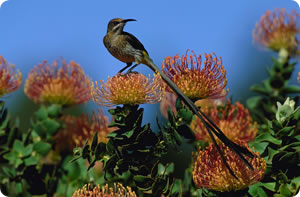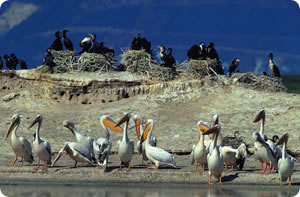
|
Home
> Things to do
> Suggested Itineraries > Accomodation / Travel > General / Other |
|

|
|
The Western Cape, and particularly Cape Town and surrounds, offers excellent opportunities for bird watching and enthusiasts will find a varied number of reserves that make for excellent viewing. The Cape's birdlife is rich and varied and 60 of Southern Africa's 86 endemics and 42 of its 84 near-endemics occur in the Western Cape region. The Western Cape is also home to varied habitats including fynbos, forest and wetlands.
Bird Locations
Cape Peninsula National Park - the habitat of the reserve is mostly coastal fynbos with long stretches of rocky and sandy shoreline. Endemics such as Cape Sugarbird, Orange-breasted Sunbird and Cape Siskin can be seen and sea watching is good in winter. The specialty of the reserve is Hottentot Button-quail, a bird that can require spending a lot of time in order to see it.
Boulder's Beach - come face to face with the African Penguin
 |
Kirstenbosch National Botanic Garden - the beautiful gardens offering both fynbos and forest vegetation offer good opportunities to view Cape Sugarbird, Orangebreasted Sunbird and occasionally Knysna Warbler.
 |
Strandfontein Sewage Works - this is the best waterbirds location in Cape Town and its possible to view over 100 species in a morning. Specials include waterfowl, African Marsh Harrier and Greater Flamingo.
West Coast National Park - this wetland site is home to a large number of migrant shorebirds. Vast areas of coastal shrubland host many endemic birds including Southern Black Korhaan, Black Harrier, Grey-backed Cisticola and Lesser Double Collared Sunbird. The tidal lagoon attracts tens of thousands of migratory waders every year as well as having numbers of resident water birds. It is one of the better spots to find Chestnut-banded Plovers.
 |
Rondevlei Nature Reserve - Rondevlei provides a good representation of a cape flats wetland. There is a diversity of duck, heron, egret and grebe present plus African Spoonbill, White Pelican and Darter. It is the best spot close to Cape Town to see the Malachite Kingfisher and, when the water levels drop in Autumn, the Ethiopian Snipe can be spotted. The coastal fynbos supports a useful variety of the birds of this habitat - including the endemic Whitebacked Mousebird.
Pelican Birding Trips
Due to the warm Agulhas current and the cold Benguela current meeting just offshore of the Cape, a great upwelling is formed creating a feeding ground for many Southern Ocean seabirds. Trips throughout the year produce numbers of pelagic species, but the best viewing is on winter trips. At least 3 species of albatross and a number of petrels, shearwaters, skuas and other specials are seen on most trips with an average of 19 true pelagic species being seen on a day trip at any time of the year.
Bird Watching Tours
In order to make the most of your time in Cape Town, there are various experienced guides who will be able to plan a day or overnight trip for you and introduce you to the birds of the Cape.
>> take a look at Bird Watch and Cape Sugarbird Tours for further details.
| top |
> The best time to go birding in the Western Cape is springtime with birding increasing towards the end of August, and the very best months being September, October and November. The best time for seabird watching is in winter during the north-westerly storms. > For further information on birdwatching in SA and Cape Town, visit sabirding.co.za |
||
